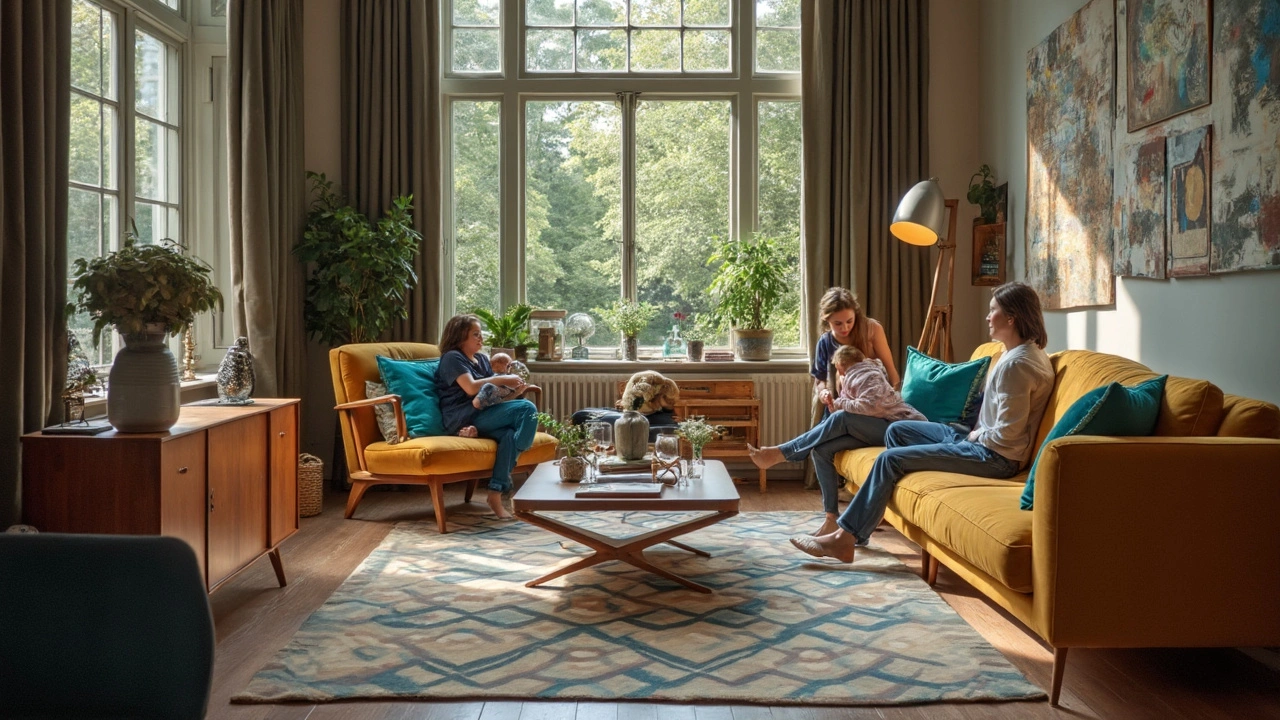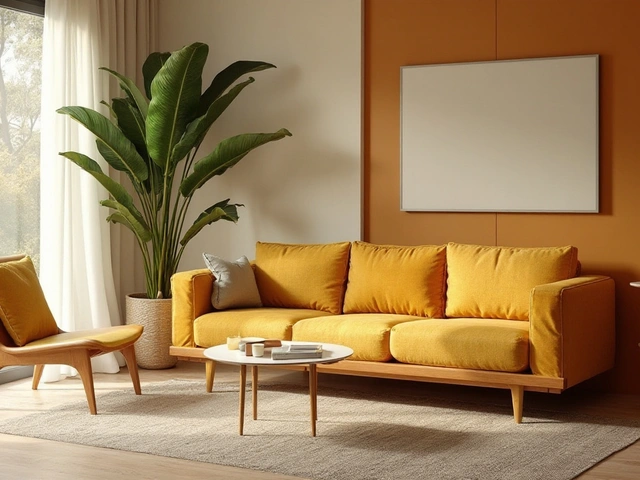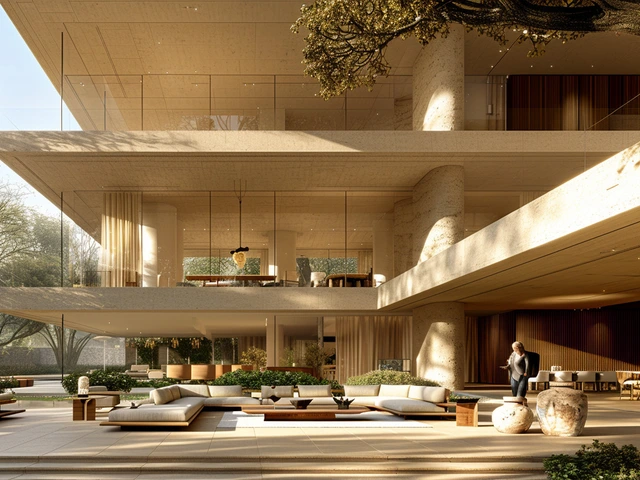Ever wondered why some living rooms just feel effortlessly cool and inviting? Chances are, mid-century modern style is working its magic. This design looks right at home whether you live in a city apartment or a family house in the suburbs. The best part? You don’t need a big budget or a design degree to get that classic yet modern vibe.
Mid-century modern is all about clean lines, simple shapes, and furniture that feels as comfy as it looks. It’s not just about chasing trends—these designs have real staying power. Even pieces designed over 70 years ago look perfectly at home with today’s tech and open layouts.
Curious how to weave in a bit of that retro charm? It starts with understanding what sets this style apart. From iconic chairs and sleek sofas to clever use of color, there’s a lot you can do to make your space feel fresh—without turning your living room into a museum.
- What Makes Mid-Century Modern Unique?
- Key Features and Iconic Pieces
- How to Spot Real vs. Reproduction
- Easy Ways to Add Mid-Century Modern Touches
- Tips for Mixing Old and New
What Makes Mid-Century Modern Unique?
Walk into a room filled with mid-century modern design and you’ll spot a few things right off the bat. The look is clean, unfussy, and always seems to feel just right—never too cold, never too cluttered. But what really makes this style one-of-a-kind?
First, it’s all about the lines. Unlike traditional furniture that’s heavy and ornate, mid-century modern pieces use simple, straight lines and smooth curves. Think low-slung couches, tapered wooden legs, and flat surfaces. This makes each piece look light and even a bit playful—no stuffy details or frilly extras.
The designers from the late 1940s to the early 1970s wanted to make furniture that felt fresh and worked for real life. After World War II, new materials like molded plastic, plywood, and aluminum became more common in furniture. Makers like Eames, Knoll, and Saarinen helped push these ideas into homes everywhere.
Color choices are another mark of this style. You’ll see a lot of natural wood tones, but also pops of bright colors like mustard yellow, teal, and burnt orange. Even the neutrals—gray, white, and black—look bolder when paired with those classic shapes.
If you’re wondering what this actually looks like in practice, check out a few key traits:
- Open, airy feeling—furniture sits off the ground, making rooms look bigger
- Big windows and an emphasis on indoor-outdoor living
- Mid-century modern uses both organic shapes (rounded edges, ovals) and geometric patterns
- Focus on function—every piece should work well and look good
Here’s a quick table showing materials and their common use in classic mid-century modern design:
| Material | Common Use |
|---|---|
| Wood (Teak, Walnut, Oak) | Tables, chairs, cabinets |
| Molded Plastic | Shell chairs, stools |
| Metal (Stainless Steel, Aluminum) | Chair legs, coffee tables |
| Glass | Table tops, accents |
All these details come together for a style that feels both retro and totally in tune with today’s need for simplicity and comfort. That’s why mid-century modern furniture looks just as cool in 2025 as it did in 1955.
Key Features and Iconic Pieces
If you want to nail the mid-century modern vibe, you need to know what actually makes it stand out. It’s not just about old stuff or vintage colors—there are some real design rules that define this style, and a few legendary pieces everyone should keep an eye out for.
First up, mid-century modern is famous for these design features:
- Clean lines and gentle curves: Think straight, simple shapes with rounded edges. Nothing fussy or overly fancy here.
- Natural materials: Wood is a big deal, especially teak and walnut. These woods bring out warm, rich tones that make spaces feel comfortable.
- Bold pops of color: You’ll see deep blues, burnt oranges, mustard yellows, and olive greens mixed with white or neutral backdrops.
- Tapered legs: Look for chairs, sofas, and even dressers sitting on slim, angled legs. It keeps everything looking light and airy.
- Function-first design: Every item has a clear purpose—furniture is built to be used, not just admired.
There are some mid-century modern pieces even people who don’t follow design know by sight. These icons have stood the test of time and show up in all kinds of places from old movies to the latest IKEA catalogues:
- Eames Lounge Chair and Ottoman: Designed by Charles and Ray Eames in 1956, this chair is pure comfort and style. You’ll still see it in high-end offices and living rooms all over the world.
- Noguchi Coffee Table: Created by Isamu Noguchi, this table mixes glass and sculpted wood in a way that looks modern no matter what year it is.
- Arne Jacobsen Egg Chair: Shaped almost like a cozy nest, the Egg Chair is a favorite for anyone who likes statement seating that’s also functional.
- George Nelson Platform Bench: Simple slatted wood with a low profile—this bench works as extra seating or just as a spot for plants and books.
- Saarinen Tulip Table: Say goodbye to chunky, four-legged tables. This single-stem base design by Eero Saarinen frees up legroom and looks sleek in any kitchen or dining space.
Wondering why people still go crazy for these designs? They’re more than just cool looking—they actually make everyday spaces feel functional and open. And if you want a quick peek at mid-century modern’s staying power, just check out this fun fact:
| Iconic Piece | Original Year | Still in Production? |
|---|---|---|
| Eames Lounge Chair | 1956 | Yes |
| Noguchi Coffee Table | 1947 | Yes |
| Egg Chair | 1958 | Yes |
So if you’re eyeing a mid-century modern sofa or dining set, you’re not just following a trend—you’re buying into a real piece of design history that still makes sense for how we live today.

How to Spot Real vs. Reproduction
Walk into any vintage shop or browse online and you’ll see loads of mid-century modern furniture. But not everything labeled “mid-century” is actually old or valuable. There’s a mix of genuine pieces from the '40s to the '60s and modern reproductions that just borrow the look. So, how do you tell the difference?
The fastest way is to look for maker’s marks or labels. Big names like Herman Miller, Knoll, and Drexel almost always stamped their products—or added a sticker somewhere underneath or on the back. If there’s a label with a serial number or the designer’s name, that’s a strong sign you’re looking at the real thing.
- Materials count: Real mid-century modern pieces often use solid wood like teak, walnut, or rosewood. Reproductions usually rely on cheaper veneers or particleboard.
- Check the joints: Older furniture will show signs of craftsmanship, like dovetail joints or smooth, hand-sanded edges. Newer knock-offs use screws or staples and may feel flimsy if you give them a shake.
- Weight matters: Authentic chairs, tables, and cabinets almost always feel heavier because the woods were denser and hardware was built to last.
- Hardware hints: Real pieces often have brass or metal hardware that’s nicely worn, not shiny and new. Beware of plastic handles or too-perfect paint jobs.
If you’re buying online, ask for close-up photos of labels, joints, and any damage. Good sellers won’t hide these details. Reproductions are fine if you just want the look, but knowing what you’re getting helps you pay the right price. For example, an authentic Eames lounge chair with original leather can easily cost $5,000 or more, while a decent replica goes for under $1,000.
| Feature | Real (1940s-60s) | Reproduction |
|---|---|---|
| Label/Stamp | Exists (often branded) | Often missing or generic |
| Materials | Solid wood, high-quality fabrics | Veneer, plywood, cheaper textiles |
| Hardware | Brass, steel, natural wear | Plastic, glossy new |
| Craftsmanship | Dovetail, hand-sanded | Stapled, machine-made |
There’s nothing wrong with modern reproductions—they can be comfy, stylish, and much easier on your wallet. But spotting the real stuff is all about the details. Next time you spot what looks like a treasure, take a minute to check underneath, feel the weight, and look for those telltale labels and craftsman’s touches.
Easy Ways to Add Mid-Century Modern Touches
You don’t need a full home makeover to bring in some mid-century modern charm. A few changes here and there can really make a big difference. Start with swapping out bulky or fussy furniture for pieces with simple lines and tapered legs. Think of those classic Eames lounge chairs or a kidney-shaped coffee table. Even just one strong piece can anchor the vibe in your living room.
Don’t skip lighting. Mid-century modern lighting is super recognizable—think Sputnik chandeliers and globe floor lamps. If you only want to try one thing, swapping in a retro-looking lamp is a low-risk, high-reward move.
- Mid-century modern furniture often comes in walnut, teak, or oak. Look for warm wood tones when choosing tables, TV stands, or bookshelves.
- Go for solid, bold colors on cushions or rugs—like mustard yellow, teal, or burnt orange. These colors aren’t just random; they were staples of mid-century modern decor in the 1950s and 60s.
- Add some geometric patterns. A couple of pillows or a simple wall print with triangles or boomerangs can signal retro cool without overwhelming the room.
- Try swapping your cabinet pulls or drawer handles for something sleek and understated. Sometimes the small changes stand out the most.
If you love houseplants, this is your moment—they pair perfectly with mid-century modern. Pop a fiddle-leaf fig or snake plant in a ceramic planter and you’ve got an instant style upgrade.
Even tech can blend in. Modern TVs or speakers can sit on a vintage credenza without looking out of place. Sometimes that mix of the old and new is what makes a space really stand out.
For renters or anyone on a budget, stores like IKEA and West Elm offer affordable mid-century modern inspired furniture and decor. Vintage shops or online marketplaces often have original pieces, but reproductions can get you the look for less. Here’s a quick price comparison of popular options:
| Item | Authentic Vintage | Reproduction |
|---|---|---|
| Eames Lounge Chair | $5,000+ | $600-$1,200 |
| Teak Sideboard | $2,000+ | $300-$900 |
| Sputnik Chandelier | $800+ | $100-$300 |
Small changes add up fast, so don’t stress about getting everything perfect at once. Pick a few touches that you love, and the laid-back, classic vibe will start to shine in your home.

Tips for Mixing Old and New
Getting that cool mid-century modern look isn’t about going full-on retro or tossing out everything you own. In fact, the sweet spot comes when you blend vintage pieces with newer finds. It makes your space feel lived-in, current, and totally one-of-a-kind.
Start with a standout piece—like a vintage mid-century modern lounge chair or a teak sideboard. These icons work as eye-catchers and give you a launching point for the rest of the room.
- Balance Shapes: Pair the clean lines of classic mid-century sofas with modern, plush rugs or soft-edged coffee tables. The mix makes the style less rigid.
- Layer Textures: Bring in today’s textures (like chunky knit throws or faux fur cushions) to contrast with the smooth wood and fabrics of vintage furniture.
- Use Color with Purpose: Mid-century pieces love color but keep it simple. Use a bold accent chair with neutral walls, or a modern lamp in vintage yellow or orange. Don’t overdo it—two or three pops is enough.
- Mix Artwork: Hang up some geometric prints alongside family photos or even that abstract canvas you picked up at the farmer’s market. The contrast keeps art from feeling stuffy.
- Accessorize Smart: Update a vintage credenza with modern vases or tech gadgets—it’s a low-cost way to keep things feeling fresh.
If you’re wondering how well old and new people stuff play together, here’s a quick look at how much homes really blend these styles:
| Blend Type | % of Homeowners (2024 survey) |
|---|---|
| Mostly Vintage | 12% |
| Even Mix of Old & New | 57% |
| Mostly New | 31% |
And remember, you don’t have to ditch your favorite things. That IKEA sofa or smart speaker can look right at home next to a well-loved walnut desk. It’s all about thoughtful combos. Try swapping out hardware on modern dressers for brass pulls, or hanging globe pendants (a classic mid-century modern move) over a brand-new kitchen island. Mixing is what keeps your space true to you.





